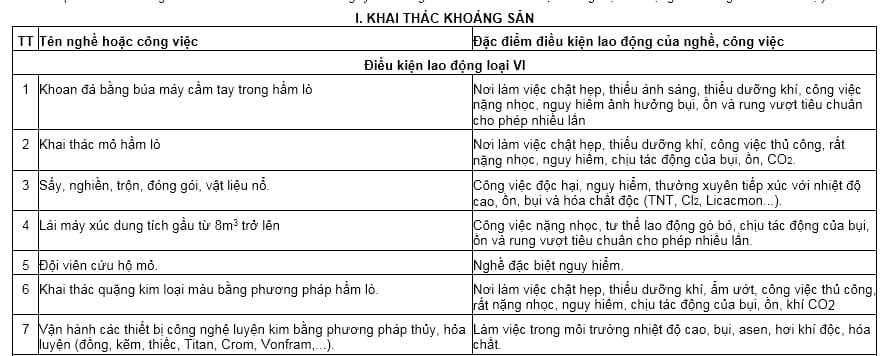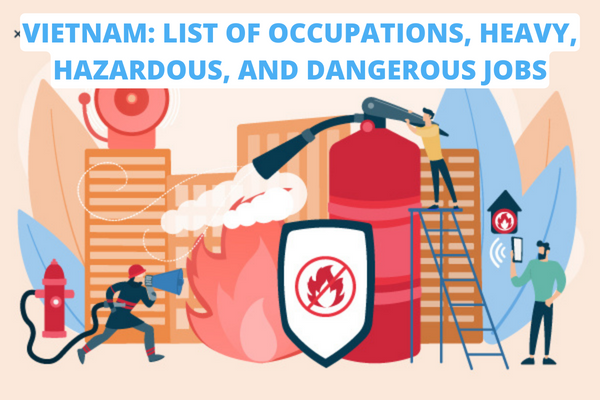Vietnam: List of occupations, heavy, hazardous, and dangerous jobs in 2022? Rights of employees when doing arduous, hazardous, or dangerous jobs?
What is arduous, hazardous and dangerous jobs in Vietnam?
Heavy, hazardous and dangerous jobs are jobs that, when performed, will have elements that cause harm, damage to health, spirit or have high risks and are specified in the list of occupations and heavy jobs, laborious, toxic and dangerous in Circular 11/2020/TT-BLDTBXH.
Current list of occupations, heavy, hazardous and dangerous jobs according to Vietnamese regulations?
Circular 11/2020/TT-BLDTBXH stipulates 1838 occupations and jobs with heavy, hazardous and dangerous elements and is divided into 31 different fields according to which:
- Mining: 108 occupations/jobs;
- Mechanics, metallurgy: 180 occupations/jobs;
- Chemicals: 159 occupations/jobs;
- Transport: 100 occupations/jobs;
- Construction of traffic and warehouses and yards: 58 occupations/jobs;
- Electricity: 100 occupations/jobs;
- Communication, post and telecommunications: 39 occupations/jobs;
- Cement production: 39 occupations/jobs;
- Crockery, glass, plastic groceries, paper, wood: 52 occupations/jobs;
- Leather, footwear, textiles: 58 occupations/jobs;
- Agriculture and forestry (including cultivation, exploitation, processing of agricultural and forestry products, animal husbandry and processing of cattle and poultry): 118 occupations/jobs;
- Trade: 47 occupations/jobs;
- Radio and television: 18 occupations/jobs;
- National reserve: 05 occupations/jobs;
- Healthcare and pharmacy: 66 occupations/jobs;
- Irrigation: 21 occupations/jobs;
- Core: 17 occupations/jobs;
- Geology: 24 occupations/jobs;
- Construction (construction): 12 occupations/jobs;
- Environmental sanitation: 27 occupations/jobs;
- Producing bricks, ceramics, porcelain, stone, sand, gravel, building glass, building materials: 46 occupations/jobs;
- Tobacco production: 32 occupations/jobs;
- Cadastral: 06 occupations/jobs;
- Hydrometeorology: 08 occupations/jobs;
- Science and technology: 57 occupations/jobs;
- Aviation: 55 occupations/jobs;
- Production and processing of table salt: 03 occupations/jobs;
- Physical education - sports, culture and information: 47 occupations/jobs;
- Invalids and society: 14 occupations/jobs;
- Confectionery, beer, wine, beverage: 23 occupations/jobs;
- Tourism: 08 occupations/jobs;
- Banking: 16 occupations/jobs;
- Paper production: 24 occupations/jobs;
- Fisheries: 38 occupations/jobs;
- Petroleum: 119 occupations/jobs;
- Food processing: 14 occupations/jobs;
- Education - training: 04 occupations/jobs;
- Customs: 09 occupations/jobs;
- Manufacture of automobiles and motorcycles: 23 occupations/jobs;
- Archive: 01 occupation/job;
- Environmental resources: 24 occupations/jobs;
- Rubber: 19 occupations/jobs.
A number of industries, occupations and jobs with heavy, hazardous and dangerous elements in a number of fields:
- Mining field

- Mechanical and metallurgical fields

- Chemical field:

See the entire list of heavy, hazardous and dangerous industries and occupations: Here.

Vietnam: List of occupations, heavy, hazardous, and dangerous jobs in 2022? Rights of employees when doing arduous, hazardous, or dangerous jobs?
Rights of employees when doing arduous, hazardous or dangerous jobs according to Vietnamese regulations?
Annual leave:
Pursuant to the provisions of Clause 1, Article 113 of the Labor Code 2019, the annual leave regime is:
“Article 113. Annual leave
1. Any employee who has been working for an employer for 12 months is entitled to fully-paid annual leave, which is stipulated in his/her employment contract as follows:
a) 12 working days for employees who work in normal working conditions;
b) 14 working days for employees that are minors, the disabled, employees who do laborious, toxic or dangerous works;
c) 16 working days for employees who do highly laborious, toxic or dangerous works.
2. An employee who has been working for an employer for less than 12 months will have a number of paid leave days proportional to the number of working months.
3. An employee who, due to employment termination or job loss, has not taken or not entirely taken up his/her annual leave shall be paid in compensation for the untaken leave days.
4. The employer has the responsibility to regulate the timetable for annual leaves after consultation with the employees and must give prior notice to the employees. An employee may reach an agreement with the employer on taking annual leave in instalments or combining annual leave over a maximum period of up to 03 years.
5. When an employee takes his/her annual leave before salary payment is due, he/she may receive an advance in accordance with Clause 3 Article 101 of this Labor Code.
6. When taking annual leave, should the employee travel by road, rail, water and the travel days, the traveling time in excess to 02 days will be added to the annual leave days, and this policy shall only be granted once for an annual leave in a year.
7. The Government shall elaborate this Article.”
Accordingly, for occupations or jobs that are heavy, hazardous, dangerous or particularly heavy, toxic or dangerous on the list promulgated by the Ministry of Labor of Vietnam, War Invalids and Social Affairs of Vietnam, or by the Ministry of Health of Vietnam where there is a regional allowance coefficient of 0.7 or more, they are entitled to 40 days;
If you have paid social insurance premiums for less than 15 years; 50 days if the payment is from full 15 years to less than 30 years; 70 days if paid for full 30 years or more.
Retirement age:
Pursuant to the provisions of Clause 3, Article 169 of the Labor Code 2019, the retirement age is:
“Article 169. Retirement ages
…
3. The retirement ages of employees who suffer from work capacity reduction; doing laborious, toxic or dangerous works; working in highly disadvantaged areas may be younger by up to 05 years than the retirement ages specified in Clause 2 of this Article, unless otherwise prescribed by law.”
Those who work in areas with extremely difficult socio-economic conditions may retire at a lower age but not more than 05 years old compared to the provisions in Clause 2, Article 169 of the Labor Code 2019 of Vietnam at the time of retirement unless otherwise provided by law.
The above is a list of occupations, heavy, hazardous and dangerous jobs and benefits that employees can receive when doing occupations in the above list.
LawNet
